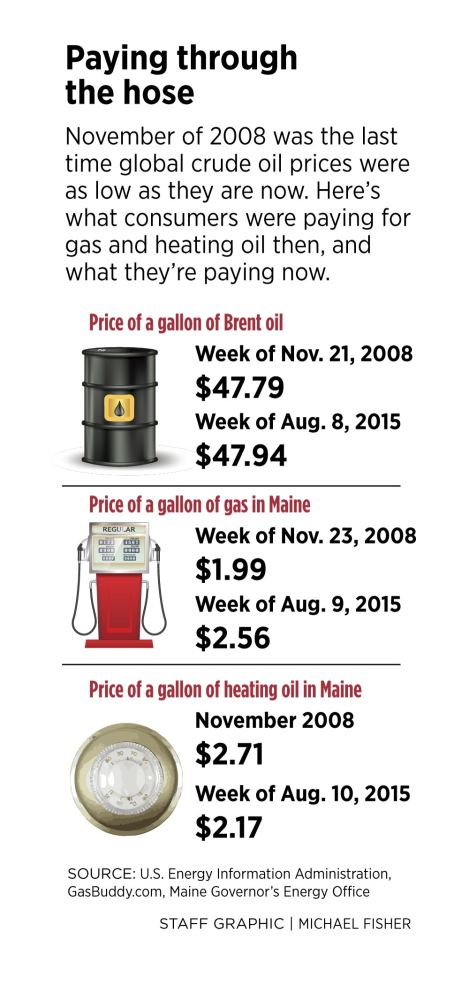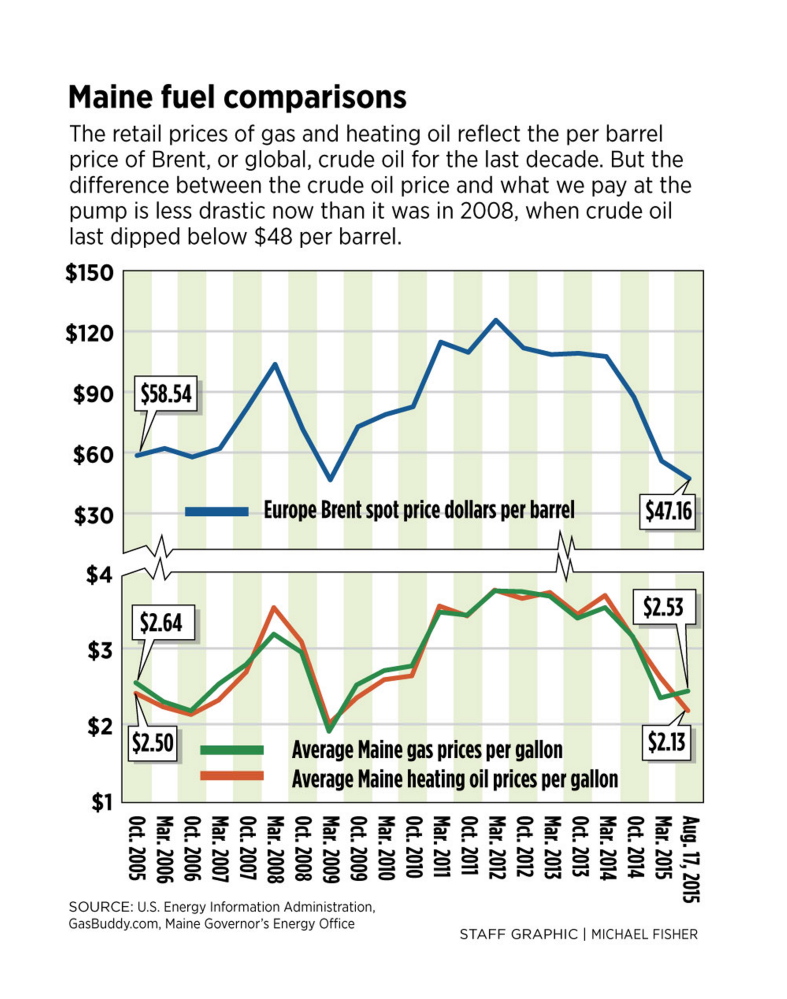A barrel of crude oil was selling for $47 Friday on the global market. The last time it was that cheap, consumers were paying an average of $1.87 at the pump in December 2008.
So why are you paying around $2.60 today for a gallon of gas?
The short answer is, well, there is no short answer.
Petroleum and energy analysts say that oil and gas are their own commodities, each subject to its own market influences.
“Sometimes they can become estranged,” said Patrick DeHaan, senior petroleum analyst for GasBuddy.com, a company that tracks and analyzes gas markets.
Small consolation for consumers who want to see more dramatic fuel savings, but a reflection of the increasingly complex world of oil markets, which are affected by factors as seemingly random as the number of cars on the road in China, Saudi Arabia’s decision not to curtail oil production and Russia’s invasion of eastern Ukraine. Oh, and taxes.
“The supply chain takes so many twists and turns, so you can’t look at crude oil prices being down and say, ‘Gas should be down,’ ” says Denton Cinquegrana, chief oil analyst for the Oil Price Information Service, a Maryland-based company that collects and reports on prices for petroleum products. “It’s definitely not a one-to-one relationship.”
That’s not to say the price for oil isn’t the major driver of gasoline prices. It is, but there’s a lag before changes in oil prices are reflected at the pump, DeHaan said. Likewise the impact on heating oil, which averaged $2.13 on Monday, down 37 percent from this time last year, when it averaged $3.39 per gallon.
Here’s a breakdown of why we pay what we do:
DECONSTRUCTING THE COST OF GAS
The cost of oil (a barrel contains 42 gallons of oil, which produces roughly 19 gallons of gasoline) makes up anywhere from 50 percent to 70 percent of the cost of a gallon of gasoline, according to the U.S. Energy Information Administration. The other major cost factors are the refining costs and refinery profits, retail and distribution costs, retailers’ profits and state and federal taxes.
On average, a gallon of gasoline in the United States in June cost $2.80. The cost of crude oil accounted for 51 percent of that price, according to the EIA, while refining costs (including refinery profits) contributed roughly 21.5 percent, distribution and marketing (including gas station profits) was 11.4 percent and taxes 16.2 percent.
Those cost components, however, are constantly shifting.
For example, in January, refining costs represented only 6.3 percent of the cost of a gallon of gas, which was $2.11 that month, while crude oil represented 53.7 percent, distribution and marketing represented 19.9 percent and taxes were 20.1 percent.
Since February, refining costs have represented more than 20 percent of the cost of gas. The last time refining costs represented such a significant portion of the gas prices was in June 2007, when gas was $3.05 a gallon and refining costs made up 22.7 percent of that cost. To the layperson, those numbers suggest that refineries are using low oil prices to gouge the public, but Hannah Breul of the EIA disagrees. What’s happening is much more complicated, she said.
She acknowledges that U.S. refineries are faring well at the moment, but that rather than “gouging the public,” which implies a conspiracy to gain profits in an unethical or criminal way, it’s global market forces that are benefiting refineries – especially the efficient ones in the U.S.
“(Global) demand for gas is high enough that it’s pushing the price for gas up” – high demand is keeping prices relatively high compared to the cost of oil – “but the cost side has not increased,” she said. “In fact, the cost side has gone down because crude oil prices have gone down.”
Greater demand pushes higher prices while expenses are going down – a sweet combination for refinery profits. As a result, refineries are the winners.
DIFFERENT TYPES OF CRUDE
Traditionally, when people in the United States mention crude oil prices, they’re referring to a crude oil index known as West Intermediate Crude, or WTI, which is collected at a hub in Cushing, Oklahoma. For years, this was the crude oil price most associated with gas prices in this country. But that began to change earlier this decade as the shale oil boom increased the country’s oil supply. Since 2011, retail gasoline prices have been more closely associated with what’s known as Brent crude oil, based on the price of oil originating from the North Sea in northern Europe.
“Brent crude oil prices are more important than WTI crude oil prices as a determinant of U.S. gasoline prices,” concluded an October 2014 report from the EIA. As a result, we’ve used Brent oil prices in the accompanying chart. Recent headlines touting crude oil prices – for WTI, not Brent – dipping below $40 a barrel this past week are precipitated by the fact that “U.S. crude oil inventories remain near levels not seen for this time of year in at least the last 80 years,” according to the EIA.
YOU CAN’T GET THERE FROM HERE
The last time a barrel of Brent oil cost $47, except for a slight dip this past winter, was during the winter of 2008-09. At the time, the average price for a gallon of gas in Maine was below $2 a gallon. So why isn’t gas below $2 a gallon today?
The answer involves the aforementioned refinery costs and the wholesale price of gas the refineries are offering retailers. Seasonal factors are an issue, too.
The wholesale price of gas is the baseline for determining what consumers pay at the pump, according to Jamie Py, executive director of the Maine Energy Marketers Association, which represents Maine’s gas stations and heating oil dealers.
“You can’t get (below $2 a gallon) with the wholesale prices where they are,” Py said.
The average wholesale price for a gallon of regular unleaded gas arriving at Portland Harbor on Monday was $1.87, according to the Oil Price Information Service. Maine receives most of its gasoline from the Irving refinery in Saint John, New Brunswick.
That’s the price gas stations paid for the gas, said Py. From there, Maine adds roughly 30 cents per gallon in excise tax, while the federal government adds roughly 18 cents. Add 5 cents per gallon in transportation costs to get the gas from the harbor to the gas station, and then a few cents to account for credit card fees and Py comes up with roughly $2.43 a gallon.
But gas stations still need to make a small profit on each gallon sold. Py said he doesn’t discuss profit margins with his members, but cites a study from the National Association of Convenience Stores that says gas stations’ profit margins on each gallon of gas are between 2 cents and 4 cents.
So, Maine’s gas stations can offer gas that arrived with a wholesale price of $1.87 per gallon for $2.45 to $2.47 a gallon.
“That’s right in the ballpark,” Py said. “Nothing is really out of line there.”
The lowest price for a gallon of gasoline in Portland on Aug. 19 was $2.47 at BJ’s on Warren Avenue, while the statewide average was $2.54 a gallon, according to GasBuddy.com.
‘ROCKETS AND FEATHERS’
Gas prices track oil prices, but they tend to increase quickly when the cost of oil is rising, and are slower to fall when the price of oil goes down. This asymmetry has been studied so often by economists that there’s actually a term for it: the “rockets and feathers” phenomenon. The price of gas goes up like a rocket when oil prices rise, but falls like a feather when oil prices decrease.
The reason for the phenomenon is counterintuitive, according to DeHaan at GasBuddy.com. The popular belief is that as gas prices rise, so do the profits for gas stations. But DeHaan said that’s not actually the case. When gas stations increase prices, their margins become “razor-thin.” They have to increase prices to cover the increased cost of the gas delivered to their stations. But increase it too much and they will send customers to competitors. DeHaan notes that customers are more likely to comparison-shop for gas when prices are rising and less so when they seem stable or are declining. A gas station’s business model relies on attracting customers for the gas and then getting them into the accompanying convenience store where the higher-profit-margin items are for sale.
Because of this dynamic, stations increase gas prices quickly to get the pain over with. Then, when the wholesale cost of gas is going down, stations are slower to pass along those savings to consumers so proprietors can take advantage of brief, but wider, profit margins, he said.
“When there’s an opportunity that gas stations can make a better profit, they take their time dropping prices,” DeHaan said. “Gas stations do pass the savings along, but it takes some time to do it because they’re in no rush to kill their bottom line. Theoretically, if stations dropped prices as fast as their own costs go down they’d be in a world of trouble.”
Cinquegrana compared the phenomenon with how retail stores rely on Christmas to get into the black.
“It’s sometimes a situation where this two-week period – I’m just speaking theoretically – may make their year,” he said.
“It is in this ‘feathers’ stage of rockets and feathers that retailers need to earn enough profit on sales to cover much of the fixed costs of operating a station,” concluded Michael Noel, an economics professor at Texas Tech University, in a 2012 study.
As a result, Noel found that: “Rockets and feathers are not anti-competitive and there is no reason to suspect consumers are hurt by them.”
SUMMER BLEND PRICIER
The seasons play a large part in what consumers pay at the pump for two reasons. First, the obvious one: People drive more during the summer. That increases demand, and therefore prices. The other seasonal factor is that the gas you buy in the summer is not the same mix as the type you buy in the winter. Refineries are required by law to produce different blends for the seasons, putting additives in the summer blend to reduce pollution, which increases the cost of that gas. Cinquegrana uses the analogy of a baker who uses conventional flour most of the year, but is required to cook with the more expensive gluten-free flour during the summer.
“The summer blend is more expensive,” he said.
COST OF HEATING OIL
Nearly seven out of every 10 Maine households heat with oil – the highest ratio in the nation, according to EIA.
Like regular gas, the relationship between crude oil prices and the cost of heating oil is not a direct relationship, according to Lisa Smith, senior planner at the Maine Governor’s Energy Office.
“It’s not a parallel thing,” she said.
There is some overlap in where Maine gets its heating oil and its gasoline, Smith said. Some of Maine’s heating oil comes from Canada, but it also comes from refineries in New York and New Jersey, the Gulf Coast, and even a small amount from refineries in the Caribbean, according to Smith.
Like gas, the retail price of heating oil is affected by refinery costs, and distribution and marketing costs. Heating oil costs are also much more seasonal, because demand spikes in the wintertime. But in the end, the price of oil is still the largest driver of heating oil prices, she said. And there’s currently more oil than people know what to do with.
“We don’t have those robust booming economies that would require that extra supply, so we have a lot of people sitting on a lot of oil, and not a lot of takers,” she said. “It’s a buyers’ market.”
Send questions/comments to the editors.



